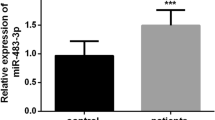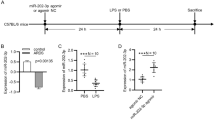Abstract
Pneumonia is usually caused by a wide variety of pathogen infection. The underlying mechanism contributing to pneumonia remains elusive. Here, the role of microRNA-497-3p (miR-497-3p) was explored in bacterial pneumonia. The expression levels of miR-497-3p and procalcitonin (PCT) in patient serum were detected by real-time polymerase chain reaction (RT-PCR) and enzyme-linked immunosorbent assay (ELISA), respectively. The interaction between miR-497-3p and PCT was further verified in A549 cell line. To further explore the role of miR-497-3p in pneumonia, mouse model of bacterial pneumonia was established via Sp TIGR4 strain (SpT4) infection. Subsequently, LV-miR-497-3p sponge was administrated in mice with bacterial pneumonia. The severity of pneumonia and inflammatory response were evaluated. Serum miR-497-3p and PCT levels increased in patients with bacterial pneumonia and miR-497-3p level positively corrected with the PCT level. The functional assay demonstrated that CALCA is the target of miR-497-3p in the A549 cell line. In mice with bacterial pneumonia, both miR-497-3p and PCT levels were upregulated after SpT4 infection. LV-miR-497-3p sponge administration attenuated pneumonia, accompanied with increasing gain of bodyweight and blood oxygen levels, as well as uninjured lungs. miR-497-3p inhibition attenuates the expression of C-reactive protein (CRP) and inflammatory cytokines in lung tissues of SpT4-infected mice, including nterleukin-6 (IL-6) and tumor necrosis factor-α (TNF-α). In conclusion, inhibition of miR-497-3p downregulates the expression of procalcitonin and ameliorates bacterial pneumonia in mice.





Similar content being viewed by others
References
Mandell, L.A. 2015. Community-acquired pneumonia: an overview. Postgraduate Medicine 127: 607–615.
Thomas, C.F., Jr., and A.H. Limper. 2004. Pneumocystis pneumonia. The New England Journal of Medicine 350: 2487–2498.
Pfuntner, A., L.M. Wier, and C. Stocks. 2006. Most frequent conditions in U.S. hospitals, 2010: Statistical Brief #148. Healthcare Cost and Utilization Project (HCUP) Statistical Briefs. Rockville: Agency for Healthcare Research and Quality (US).
Matuschak, G.M., and A.J. Lechner. 2010. Acute lung injury and the acute respiratory distress syndrome: pathophysiology and treatment. Missouri Medicine 107: 252–258.
Jamieson, A.M., L. Pasman, S. Yu, P. Gamradt, R.J. Homer, T. Decker, and R. Medzhitov. 2013. Role of tissue protection in lethal respiratory viral-bacterial coinfection. Science 340: 1230–1234.
Skalski, J.H., T.J. Kottom, and A.H. Limper. 2015. Pathobiology of Pneumocystis pneumonia: life cycle, cell wall and cell signal transduction. FEMS Yeast Research 15: fov046.
Marriott, H.M., and D.H. Dockrell. 2006. Streptococcus pneumoniae: the role of apoptosis in host defense and pathogenesis. The International Journal of Biochemistry & Cell Biology 38: 1848–1854.
Henig, O., and K.S. Kaye. 2017. Bacterial pneumonia in older adults. Infectious Disease Clinics of North America 31: 689–713.
Aujla, S.J., Y.R. Chan, M. Zheng, M. Fei, D.J. Askew, D.A. Pociask, T.A. Reinhart, F. McAllister, J. Edeal, K. Gaus, S. Husain, J.L. Kreindler, P.J. Dubin, J.M. Pilewski, M.M. Myerburg, C.A. Mason, Y. Iwakura, and J.K. Kolls. 2008. IL-22 mediates mucosal host defense against Gram-negative bacterial pneumonia. Nature Medicine 14: 275–281.
Bartel, D.P. 2004. MicroRNAs: genomics, biogenesis, mechanism, and function. Cell 116: 281–297.
Croce, C.M., and G.A. Calin. 2005. miRNAs, cancer, and stem cell division. Cell 122: 6–7.
Guo, S., Y. Chen, J. Liu, J. Yang, C. Yang, T. Zhang, K. Jiang, Z. Wu, A. Shaukat, and G. Deng. 2019. miR-497a-5p attenuates lipopolysaccharide-induced inflammatory injury by targeting IRAK2. Journal of Cellular Physiology 234: 22874–22883.
Ma, W., Y. Kang, L. Ning, J. Tan, H. Wang, and Y. Ying. 2017. Identification of microRNAs involved in gefitinib resistance of non-small-cell lung cancer through the insulin-like growth factor receptor 1 signaling pathway. Experimental and Therapeutic Medicine 14: 2853–2862.
Self, W.H., R.A. Balk, C.G. Grijalva, D.J. Williams, Y. Zhu, E.J. Anderson, G.W. Waterer, D.M. Courtney, A.M. Bramley, C. Trabue, S. Fakhran, A.J. Blaschke, S. Jain, K.M. Edwards, and R.G. Wunderink. 2017. Procalcitonin as a marker of etiology in adults hospitalized with community-acquired pneumonia. Clinical Infectious Diseases 65: 183–190.
Wang, Y., B. Jiang, Y. Guo, W. Li, Y. Tian, G.F. Sonnenberg, J.N. Weiser, X. Ni, and H. Shen. 2017. Cross-protective mucosal immunity mediated by memory Th17 cells against Streptococcus pneumoniae lung infection. Mucosal Immunology 10: 250–259.
Yook, Y.S., J.S. Jeon, J.O. Park, and J.K. Kim. 2018. Laboratory investigation of trends in bacterial pneumonia in Cheonan, Korea, from January 2008 to September 2017. Journal of Microbiology and Biotechnology 28: 1730–1735.
Ambros, V. 2004. The functions of animal microRNAs. Nature 431: 350–355.
Bartel, D.P. 2009. MicroRNAs: target recognition and regulatory functions. Cell 136: 215–233.
Shen, L., J. Li, L. Xu, J. Ma, H. Li, X. Xiao, et al. 2012. miR-497 induces apoptosis of breast cancer cells by targeting Bcl-w. Experimental and Therapeutic Medicine 3: 475–480.
Zhu, W., D. Zhu, S. Lu, T. Wang, J. Wang, B. Jiang, Y. Shu, and P. Liu. 2012. miR-497 modulates multidrug resistance of human cancer cell lines by targeting BCL2. Medical Oncology 29: 384–391.
Chen, X., C. Shi, C. Wang, W. Liu, Y. Chu, Z. Xiang, K. Hu, P. Dong, and X. Han. 2017. The role of miR-497-5p in myofibroblast differentiation of LR-MSCs and pulmonary fibrogenesis. Scientific Reports 7: 40958.
Funding
The study was supported by the Cangzhou Science and Technology Research and Development Program (cz151302039).
Author information
Authors and Affiliations
Corresponding author
Ethics declarations
Conflict of Interest
The authors declare that they have no conflict of interest.
Additional information
Publisher’s Note
Springer Nature remains neutral with regard to jurisdictional claims in published maps and institutional affiliations.
Rights and permissions
About this article
Cite this article
Wang, W., Zhu, Y., Yin, L. et al. Inhibition of miR-497-3p Downregulates the Expression of Procalcitonin and Ameliorates Bacterial Pneumonia in Mice. Inflammation 43, 2119–2127 (2020). https://doi.org/10.1007/s10753-020-01279-w
Published:
Issue Date:
DOI: https://doi.org/10.1007/s10753-020-01279-w




